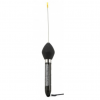Pop-up satellite archival tags (PSATs)
 Pop-up satellite archival tags (PSATs) are satellite tags and archival tags combined in the same package. Their major advantage is that instead of having to retrieve the animal carrying the tag to get the data, these devices send the data to the researcher via satellite. They have been deployed with a high level of success on a variety of animals around the globe including tuna, marlin, sharks, swordfish, mola mola, halibut, eels and sea turtles. Pop-up satellite archival tags are designed to track the large-scale movements and behavior of animals that don’t spend enough time at the oceans’ surface to allow the use of a traditional satellite tags (see below) and are not highly exploited (that is you cannot get the archival tag back). The ability to obtain the data without the animal being recaptured is extremely important as the tag permits fisheries-independent means of tracking species. No human intervention is required to get the data.
Pop-up satellite archival tags (PSATs) are satellite tags and archival tags combined in the same package. Their major advantage is that instead of having to retrieve the animal carrying the tag to get the data, these devices send the data to the researcher via satellite. They have been deployed with a high level of success on a variety of animals around the globe including tuna, marlin, sharks, swordfish, mola mola, halibut, eels and sea turtles. Pop-up satellite archival tags are designed to track the large-scale movements and behavior of animals that don’t spend enough time at the oceans’ surface to allow the use of a traditional satellite tags (see below) and are not highly exploited (that is you cannot get the archival tag back). The ability to obtain the data without the animal being recaptured is extremely important as the tag permits fisheries-independent means of tracking species. No human intervention is required to get the data.
Pop-up satellite archival tags record the same environmental data as an archival tag- pressure, ambient temperature and light. In addition, full archival data records are maintained in non-volatile memory (memory that retains its contents when power is turned off). Thus, should a PSAT happen to be recovered, researches have the same detailed data that are collected by an archival tag.
Attachment methods for pop-up satellite archival tags differ depending on the animals to which the tags will be secured. To attach a tag to a fish, scientists insert a small anchor into the animal being tagged or externally place the device on the animal. The anchor is made of surgical material that doesn’t harm the fish. On mammals or turtles, the same device gets anchored by adhesives to the shell or fur. In either case, a monofilament “attachment strap” connects the tag to the anchor. The monofilament loops around a metal pin at the base of the tag, and this metal pin is connected to a battery. A clock incorporated into the tag is programmed to turn the battery on at a preprogrammed time. When the battery turns on, it causes electrolysis and the attachment pin dissolves in about 10 minutes. Once the pin has dissolved the tag floats to the surface and starts transmitting data to one of the Argos satellites. The battery power is sufficient for the tag to transmit for up to 2 weeks. The results of the processed data provide the migration path taken by the study animal, depth and temperature preferences, as well as oceanographic data in the form of depth-temperature profiles
